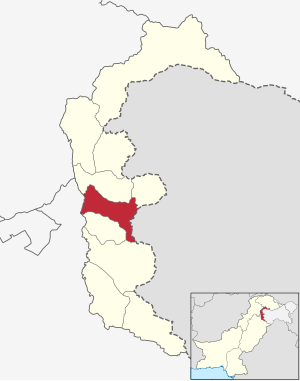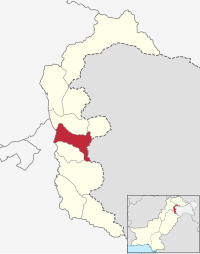پونڇ ضلعو
| پونڇ ضلعو ضلع پونچھ | |
|---|---|
| پاڪستان جي زير انتظام آزاد ڄمو ۽ ڪشمير جو ضلعو[1] | |
  ٽاپ: پونڇ جي وادي باٽم: ٽولي پير | |
 پونڇ ضلعي جو نقشو | |
![A map showing Pakistani-administered آزاد ڪشمير (shaded in sage green) in the disputed Kashmir region[1]](http://upload.wikimedia.org/wikipedia/commons/thumb/8/84/Kashmir_region._LOC_2003626427_-_showing_sub-regions_administered_by_different_countries.jpg/250px-Kashmir_region._LOC_2003626427_-_showing_sub-regions_administered_by_different_countries.jpg) A map showing Pakistani-administered آزاد ڪشمير (shaded in sage green) in the disputed Kashmir region[1] | |
| جاگرافي بيهڪ (Rawalakot): 33°51′12″N 73°45′5″E / 33.85333°N 73.75139°E | |
| ملڪ جن جي زير انتظام آزاد آھي | پاڪستان |
| زیر انتظام علایقو | آزاد ڪشمير |
| ڈویزن | پونڇ ڈویزن |
| ھیدڪوارٽر | راولاڪوٽ |
| حڪومت | |
| • قسم | ضلعي انتظامیا |
| • ڈپٽي ڪمشنر | N/A |
| • ڈسٽرڪٽ پولیس آفیسر | N/A |
| • ضلعي صحت آفيسر | N/A |
| پکيڙ | |
| • ڪل | 855 ڪ.م2 (330 ميل2) |
| آبادي (2017ع)[2] | |
| • ڪل | 5,00,571 |
پونڇ ضلعو (اردو: ضلع پونچھ) پاڪستان جي زير انتظام آزاد ڄمو ۽ ڪشمير جي ڏھن ضلعن مان ھڪ آھي. هن جي اتر۔اولھہ ۾ باغ ضلعو ء اتر۔اوڀر ۾ حويلي ضلعو آھی. اوڀر ۾ هندستان جي انتظام هيٺ ڪشمير جو پونڇ ضلعو، ڏکڻ ۾ آزاد ڪشمير جا سڊنوتي ۽ ڪوٽلي ضلعا ۽ اولهه ۾ پاڪستان جي صوبي پنجاب جو ضلعو راولپنڊي آهي. پونڇ ضلعو هندستان ۽ پاڪستان جي وچ ۾ وڏي ڪشمير تڪرار جو حصو آهي. ضلعي جو صدر مقام راولاڪوٽ شهر آهي. هي آزاد ڪشمير جو ٽيون وڏو آبادي وارو ضلعو آهي.
سال 1947ع ۾ آزاديءَ کان پوءِ، پونڇ ضلعي جي الهندي حصي ۾ بغاوت ٿي. سردار ابراهيم خان جي اڳواڻي ۾ باغين، پاڪستان کان مدد طلب ڪئي، جنهن هٿيار فراهم ڪيا ۽ پوءِ پشتون قبائلين کي استعمال ڪندي، پنهنجو حملو شروع ڪيو. جواب ۾، ڄمون ۽ ڪشمير جو مهاراجا هندستان ۾ شامل ٿيو ۽ تڪرار هڪ هندستان-پاڪستان جنگ ۾ تبديل ٿي ويو. جڏهن جنگ بندي جو اثر ٿيو، پونڇ ضلعي کي ٻن الڳ ضلعن ۾ ورهايو ويو. اڳوڻو هيڊ ڪوارٽر، پونڇ جو شهر، هندستاني انتظاميا هيٺ آيو، ۽ اولهندي ضلعي ۾ هڪ نئون هيڊ ڪوارٽر آخرڪار راولاڪوٽ ۾ قائم ڪيو ويو. پونڇ ضلعي جي پاڪستان جي انتظام هيٺ حصي کي پونڇ ڊويزن جي طور تي ٻيهر منظم ڪيو ويو. اصل پونڇ ضلعي جي چئن تعلقن يعني باغ، سڌنوتي، حويلي ۽ مينڌر، پونڇ ڊويزن ۾ پهريون ٻه ۽ ٽيون حصو شامل هئا. انهن ٽنهي تعلقن کي آخرڪار الڳ الڳ ضلعو بڻايو ويو، ۽ پونڇ ڊويزن جي مرڪز ۾ باغ ۽ سڌنوتي تعلقن جا حصا شامل ڪري هڪ نئون پونڇ ضلعو ٺاهيو ويو. پونڇ ضلعو سال 1955ع جي پونڇ بغاوت دوران حڪومت مخالف پرتشدد بغاوت (سڌن قبيلي جي اڳواڻي ۾) جو مکيه علائقو هو، جيڪو 1955ع جي شروعات کان 1956ع جي آخر تائين هليو.
انتظامي ڊويزنون
[سنواريو]ضلعو انتظامي طور تي چئن تعلقن ۾ ورهايل آهي:
• عباسپور
• اجیره
• راولاڪوٽ
• ٿروڙ
تعليم
[سنواريو]ٽرانسپورٽ
[سنواريو]پڻ ڏسو
[سنواريو]Poonch District (اردو: ضلع پونچھ ) is a district of Pakistan-administered آزاد ڪشمير in the disputed Kashmir region.[1] It is one of the 10 districts of this Pakistan-administered territory. It is bounded on the north by Bagh District, on the north-east by Haveli District, on the south-east by the Poonch District of Indian-administered Kashmir, on the south by Azad Kashmir's Sudhanoti and Kotli districts, and on the west by Rawalpindi District of Pakistan's Punjab Province. The Poonch District is part of the greater Kashmir dispute between India and Pakistan. The district headquarters is the city of Rawalakot. It is the third most populous district of Azad Kashmir.[4][5]
The main language is Pahari ("Punchi"), native to an estimated 95% of the population, but there are also speakers of Gujari,[6] while اردو has official status.

| پونڇ ضلعو | |
| Ponch District | |

| |
 | |
| ملڪ: | پاڪستان |
| صوبو: | آزاد ڪشمير |
| ضلعي گاديءَ جو ھنڌ: | راولاڪوٽ |
| ايراضي: | 855 چورس ڪلوميٽر |
| آبادي: | 459,000 |
| ٻوليون: | اردو، پونچي (پهاڙي-پوٽوهاري) گجري، پنجابي |
| تعلقا: | 2 |
پونڇ ضلعي جا چار تعلقا آھن؛
1. راولاڪوٽ
2. ھجيره
3. عباسپور
4. تراڙکل
 |
 |
 |
 |
حوالا
[سنواريو]- ↑ 1.0 1.1 1.2 The application of the term "administered" to the various regions of Kashmir and a mention of the Kashmir dispute is supported by the tertiary sources (a) through (e), reflecting due weight in the coverage. Although "controlled" and "held" are also applied neutrally to the names of the disputants or to the regions administered by them, as evidenced in sources (h) through (i) below, "held" is also considered politicised usage, as is the term "occupied," (see (j) below).
(a) Kashmir, region Indian subcontinent, Encyclopaedia Britannica, حاصل ڪيل 15 August 2019 (subscription required) Quote: "Kashmir, region of the northwestern Indian subcontinent ... has been the subject of dispute between India and Pakistan since the partition of the Indian subcontinent in 1947. The northern and western portions are administered by Pakistan and comprise three areas: Azad Kashmir, Gilgit, and Baltistan, the last two being part of a territory called the Northern Areas. Administered by India are the southern and southeastern portions, which constitute the state of Jammu and Kashmir but are slated to be split into two union territories.";
(b) Pletcher, Kenneth, Aksai Chin, Plateau Region, Asia, Encyclopaedia Britannica, حاصل ڪيل 16 August 2019 (subscription required) Quote: "Aksai Chin, Chinese (Pinyin) Aksayqin, portion of the Kashmir region, at the northernmost extent of the Indian subcontinent in south-central Asia. It constitutes nearly all the territory of the Chinese-administered sector of Kashmir that is claimed by India to be part of the Ladakh area of Jammu and Kashmir state.";
(c) "Kashmir", Encyclopedia Americana, Scholastic Library Publishing, صفحو. 328, ISBN 978-0-7172-0139-6 C. E Bosworth, University of Manchester Quote: "KASHMIR, kash'mer, the northernmost region of the Indian subcontinent, administered partlv by India, partly by Pakistan, and partly by China. The region has been the subject of a bitter dispute between India and Pakistan since they became independent in 1947";
(d) Osmańczyk, Edmund Jan, Encyclopedia of the United Nations and International Agreements: G to M, Taylor & Francis, صفحا. 1191–, ISBN 978-0-415-93922-5 Quote: "Jammu and Kashmir: Territory in northwestern India, subject to a dispute between India and Pakistan. It has borders with Pakistan and China."
(e) Talbot, Ian, A History of Modern South Asia: Politics, States, Diasporas, Yale University Press, صفحا. 28–29, ISBN 978-0-300-19694-8 Quote: "We move from a disputed international border to a dotted line on the map that represents a military border not recognized in international law. The line of control separates the Indian and Pakistani administered areas of the former Princely State of Jammu and Kashmir.";
(f) Skutsch, Carl, "China: Border War with India, 1962", ۾ Ciment, James, Encyclopedia of Conflicts Since World War II, London and New York: Routledge, صفحو. 573, ISBN 978-0-7656-8005-1,The situation between the two nations was complicated by the 1957–1959 uprising by Tibetans against Chinese rule. Refugees poured across the Indian border, and the Indian public was outraged. Any compromise with China on the border issue became impossible. Similarly, China was offended that India had given political asylum to the Dalai Lama when he fled across the border in March 1959. In late 1959, there were shots fired between border patrols operating along both the ill-defined McMahon Line and in the Aksai Chin.
(g) Clary, Christopher, The Difficult Politics of Peace: Rivalry in Modern South Asia, Oxford and New York: Oxford University Press, صفحو. 109, ISBN 9780197638408,Territorial Dispute: The situation along the Sino-Indian frontier continued to worsen. In late July (1959), an Indian reconnaissance patrol was blocked, "apprehended," and eventually expelled after three weeks in custody at the hands of a larger Chinese force near Khurnak Fort in Aksai Chin. ... Circumstances worsened further in October 1959, when a major class at Kongka Pass in eastern Ladakh led to nine dead and ten captured Indian border personnel, making it by far the most serious Sino-Indian class since India's independence.
(h) Bose, Sumantra, Kashmir: Roots of Conflict, Paths to Peace, Harvard University Press, صفحا. 294, 291, 293, ISBN 978-0-674-02855-5 Quote: "J&K: Jammu and Kashmir. The former princely state that is the subject of the Kashmir dispute. Besides IJK (Indian-controlled Jammu and Kashmir. The larger and more populous part of the former princely state. It has a population of slightly over 10 million, and comprises three regions: Kashmir Valley, Jammu, and Ladakh.) and AJK ('Azad" (Free) Jammu and Kashmir. The more populous part of Pakistani-controlled J&K, with a population of approximately 2.5 million.), it includes the sparsely populated "Northern Areas" of Gilgit and Baltistan, remote mountainous regions which are directly administered, unlike AJK, by the Pakistani central authorities, and some high-altitude uninhabitable tracts under Chinese control."
(i) Fisher, Michael H., An Environmental History of India: From Earliest Times to the Twenty-First Century, Cambridge University Press, صفحو. 166, ISBN 978-1-107-11162-2 Quote: "Kashmir’s identity remains hotly disputed with a UN-supervised “Line of Control” still separating Pakistani-held Azad (“Free”) Kashmir from Indian-held Kashmir.";
(j) Snedden, Christopher, Understanding Kashmir and Kashmiris, Oxford University Press, صفحو. 10, ISBN 978-1-84904-621-3 Quote:"Some politicised terms also are used to describe parts of J&K. These terms include the words 'occupied' and 'held'." - ↑ "Statistical Year Book 2019" (PDF). Statistics Azad Jammu and Kashmir. حاصل ڪيل 20 April 2020.
- ↑ Rahman, Tariq (1996). Language and politics in Pakistan. Oxford University Press. p. 226. ISBN 978-0-19-577692-8.
- ↑ "AJK at glance -2020" (PDF). Planning and Development Department of AJK.
- ↑ "University of Poonch VC Prof. Dr. Zakaria directed to complete construction of campuses on war footing". Azadi Times. حاصل ڪيل 8 August 2022.
- ↑ Statistical Year Book 2020. Muzaffarabad: AJ&K Bureau Of Statistics. p. 140. https://www.pndajk.gov.pk/uploadfiles/downloads/Statistical%20Year%20Book%202020.pdf. Retrieved 3 March 2022.
